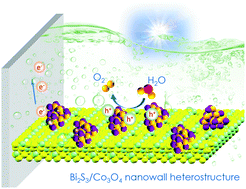Synergistic defect- and interfacial-engineering of a Bi2S3-based nanoplate network for high-performance photoelectrochemical solar water splitting†
Abstract
Photoelectrochemical (PEC) water splitting has received immense interest as a promising strategy for renewable energy generation. However, the desired efficiency is often hindered by the poor charge separation and sluggish surface reaction kinetics of the native photoanode. To address these issues, we herein demonstrate the effective modulation of the electronic structure and interface engineering strategy to improve their overall PEC performance. The defect generation in Bi2S3 is realized by a post-annealing which could increase the carrier concentration to enhance charge transfer; and a p–n Co3O4/Bi2S3 heterojunction is further built by loading Co3O4 nanostructures on the defective Bi2S3, where the resultant interfacial internal electric field further facilitates interfacial charge transfer. The optimized photoanodes yield a high photocurrent density of 7.0 mA cm−2 at 1.23 V (vs. RHE) under AM 1.5 G and an incident photon-to-current conversion efficiency of ∼85% (420 nm) with the highest charge separation (53%) and transfer efficiency (47%) for Bi2S3 to date. The incorporation of Co3O4 reduces the self-corrosion of the pristine Bi2S3 anode and thus slightly improves the stability, yet more studies are still necessary to further improve the current faradaic efficiency (67.5%) as well as the long-term service life. Overall, our contribution paves a route to boost the PEC performance of cheap native photocatalysts by using facile synergistic strategies and thus prompt the design and application of more efficient photoelectrodes for solar conversion.



 Please wait while we load your content...
Please wait while we load your content...